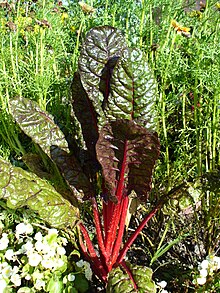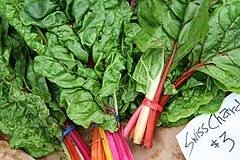Chard
| Chard | |
|---|---|
 Red-stemmed chard | |
| Species | Beta vulgaris |
| Subspecies | Beta vulgarissubsp.vulgaris |
| Cultivar group | Cicla Group, Flavescens Group |
| Origin | Sea beet (Beta vulgarissubsp.maritima) |
| Cultivar group members | Many; see text. |
ChardorSwiss chard(/tʃɑːrd/;Beta vulgarissubsp.vulgaris,Cicla Group and Flavescens Group) is a greenleafyvegetable.In thecultivarsof the Flavescens Group, theleaf stalksare large and often prepared separately from theleaf blade;[1]the Cicla Group is the leafy spinach beet. The leaf blade can be green or reddish; the leaf stalks are usually white, yellow or red.[2]
Chard, like other green leafy vegetables, has highlynutritiousleaves. Chard has been used in cooking for centuries, but because it is the same species asbeetroot,thecommon namesthat cooks and cultures have used for chard may be confusing;[3]it has manycommon names,such assilver beet,perpetual spinach,beet spinach,seakale beet,orleaf beet.[4][5]
Classification[edit]
Chard was first described in 1753 byCarl LinnaeusasBeta vulgarisvar.cicla.[6]Its taxonomic rank has changed many times: it has been treated as asubspecies,a convariety, and avarietyofBeta vulgaris.(Among the numeroussynonymsfor it areBeta vulgarissubsp.cicla(L.) W.D.J. Koch(Cicla Group),B. vulgarissubsp.cicla(L.) W.D.J. Kochvar.ciclaL.,B. vulgarisvar.cycla(L.) Ulrich,B. vulgarissubsp.vulgaris(Leaf Beet Group),B. vulgarissubsp.vulgaris(Spinach Beet Group),B. vulgarissubsp.cicla(L.) W.D.J. Koch(Flavescens Group),B. vulgarissubsp.cicla(L.) W.D.J. Kochvar.flavescens(Lam.) DC.,B. vulgarisL.subsp.vulgaris(Leaf Beet Group),B. vulgarissubsp.vulgaris(Swiss Chard Group)).[7]The accepted name for all beet cultivars, like chard,sugar beetandbeetroot,isBeta vulgarissubsp.vulgaris.[8][9]They are cultivated descendants of thesea beet,Beta vulgarissubsp.maritima.Chard belongs to thechenopods,which are now mostly included in the familyAmaranthaceae(sensu lato).
The two rankless cultivar groups for chard are the Cicla Group for the leafy spinach beet and the Flavescens Group for the stalky Swiss chard.[7]
Etymology[edit]
The word "chard" descends from the 14th-centuryFrenchcarde,fromLatincarduusmeaning artichoke thistle (orcardoonwhich also includes theartichoke) itself.[10]
The origin of the adjective "Swiss" is unclear. Some attribute the name to it having been first described by a Swiss botanist, eitherGaspard Bauhin[11]orKarl Koch[12](although the latter was German, not Swiss). Be it as it may chard is used in Swiss cuisine, e.g. in the traditional dishcapunsfrom thecanton of Grisons.

Growth and harvesting[edit]
Chard is a biennial. Clusters of chard seeds are usually sown, in the Northern Hemisphere, between June and October, the exact time depending on the desired harvesting period. Chard can be harvested while the leaves are young and tender, or after maturity when they are larger and have slightly tougher stems. Harvesting is a continual process, as most species of chard produce three or more crops.[13]
| Nutritional value per 100 g (3.5 oz) | |
|---|---|
| Energy | 84 kJ (20 kcal) |
4.13 g | |
| Sugars | 1.1 g |
| Dietary fiber | 2.1 g |
0.08 g | |
1.88 g | |
| Vitamins | Quantity %DV† |
| Vitamin A equiv. | 34% 306 μg34% 3652 μg11015 μg |
| Vitamin A | 6124 IU |
| Thiamine (B1) | 3% 0.034 mg |
| Riboflavin (B2) | 7% 0.086 mg |
| Niacin (B3) | 2% 0.36 mg |
| Pantothenic acid (B5) | 3% 0.163 mg |
| Vitamin B6 | 5% 0.085 mg |
| Folate (B9) | 2% 9 μg |
| Choline | 5% 28.7 mg |
| Vitamin C | 20% 18 mg |
| Vitamin E | 13% 1.89 mg |
| Vitamin K | 273% 327.3 μg |
| Minerals | Quantity %DV† |
| Calcium | 4% 58 mg |
| Iron | 13% 2.26 mg |
| Magnesium | 20% 86 mg |
| Manganese | 15% 0.334 mg |
| Phosphorus | 3% 33 mg |
| Potassium | 18% 549 mg |
| Sodium | 8% 179 mg |
| Zinc | 3% 0.33 mg |
| Other constituents | Quantity |
| Water | 92.65 g |
| †Percentages estimated usingUS recommendationsfor adults,[14]except for potassium, which is estimated based on expert recommendation fromthe National Academies.[15] | |
Cultivars[edit]
Cultivarsof chard include green forms, such as 'Lucullus' and 'Fordhook Giant,' as well as red-ribbed forms, such as 'Ruby Chard' and 'Rhubarb Chard.'[2]The red-ribbed forms are attractive in the garden, but as a general rule, the older green forms tend to outproduce the colorful hybrids.[citation needed]'Rainbow Chard' is a mix of colored varieties often mistaken for a variety unto itself.[2]
Chard has shiny, green, ribbed leaves, withpetiolesthat range in color from white to yellow to red, depending on the cultivar.[2]
Chard may be harvested in the garden all summer by cutting individual leaves as needed. In the Northern Hemisphere, chard is typically ready to harvest as early as April and lasts until there is a hard frost, typically below 25 °F (-4 °C).[citation needed]It is one of the hardier leafy greens, with a harvest season that typically lasts longer than that ofkale,spinach, or baby greens.
Culinary use[edit]
Fresh chard can be used raw insalads,stirfries,soups oromelets.[16]The raw leaves can be used like atortillawrap.[16]Chard leaves and stalks are typically boiled orsautéed;the bitterness fades with cooking.[16]
It is one of the most common ingredients ofCroatian cuisineinDalmatiaregion, being known as "queen of the Dalmatian garden" and used in various ways (boiled, in stews, inSoparniketc.).[17]
Nutritional content[edit]
In a 100-gram (3.5 oz) serving, raw Swiss chard provides 84 kilojoules (20 kcal) of food energy and has rich content (> 19% of theDaily Value,DV) of vitaminsA,K,andC,with 122%, 1038%, and 50%, respectively, of the DV.[18]Also having significant content in raw chard aredietary fiber,vitamin Kand thedietary mineralsmagnesium,manganese,iron,andpotassium.[18]Raw chard has a low content ofcarbohydrates,protein,andfat.[18]
Cooked chard is 93% water, 4% carbohydrates, 2% protein, and contains negligible fat. In a reference 100 g serving, cooked chard supplies 20calories,with vitamin and mineral contents reduced compared to raw chard, but still present in significant proportions of the DV, especially for vitamin A, vitamin K, vitamin C, and magnesium (see table).
References[edit]
- ^Librarie Larousse, ed. (1984).Larousse Gastronomique: The World's Greatest Cooking Encyclopedia.The Hamlyn Publishing Group Limited.
- ^abcd"Swiss chard varieties".Cornell Garden Based Learning. Ithaca, NY: Cornell University. 2016.
- ^"Swiss chard".Growing Guide. Ithaca, NY: Cornell University. 2006.
- ^"Beta vulgaris(Leaf Beet Group) ".Missouri Botanical Garden, St. Louis, MO. 2017.Retrieved19 January2017.
- ^"Production guidelines for Swiss chard"(PDF).Department of Agriculture, Forestry and Fisheries, Republic of South Africa. Archived fromthe original(PDF)on 6 April 2016.Retrieved21 May2013.
- ^Beta vulgarisvar.ciclaat Tropicos,accessed 2014-02-27
- ^abSortingBetanames at MMPNDArchived2013-05-04 at theWayback Machine
- ^Beta vulgarissubsp.vulgarisat Tropicos,accessed, 2015-02-27
- ^Beta vulgarisL. subsp.vulgaris.In: Uotila, P. (2011): Chenopodiaceae (pro parte majore). – In: Euro+Med Plantbase,accessed, 2014-02-27
- ^Chard,Online Etymological Dictionary
- ^Forget Hip Kale, Get Your Green Fix From Swiss ChardArchived2016-12-25 at theWayback Machine,Clifford Wright, Zester Daily.
- ^Chard,Centre for Urban Education about Sustainable Agriculture
- ^Dobbs, Liz (2012). "It's chard to beet".The Garden.137(6).Royal Horticultural Society:54.
- ^United States Food and Drug Administration(2024)."Daily Value on the Nutrition and Supplement Facts Labels".FDA.Archivedfrom the original on 2024-03-27.Retrieved2024-03-28.
- ^National Academies of Sciences, Engineering, and Medicine; Health and Medicine Division; Food and Nutrition Board; Committee to Review the Dietary Reference Intakes for Sodium and Potassium (2019). Oria, Maria; Harrison, Meghan; Stallings, Virginia A. (eds.).Dietary Reference Intakes for Sodium and Potassium.The National Academies Collection: Reports funded by National Institutes of Health. Washington, DC: National Academies Press (US).ISBN978-0-309-48834-1.PMID30844154.Archivedfrom the original on 2024-05-09.Retrieved2024-06-21.
- ^abc"All about Swiss chard".UnlockFood.ca, Dietitians of Canada. 2017.Retrieved5 November2019.
- ^"Blitva – Queen of the Dalmatian garden".croatiaweek.Croatia Week. 5 August 2023.Retrieved20 August2023.
- ^abc"Nutrition Facts and Analysis for Chard per 100 grams, USDA National Nutrient Database, version SR-21".Conde Nast. 2014.Retrieved2013-04-15.
